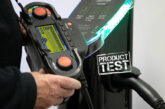
When you choose a multifunction installation tester, the main features are certainly important, says Simon Wood of Megger, but when you use it every day, you’ll find that little things also matter.
Buy a multifunction tester (MFT) from any reputable supplier and it will almost certainly do everything needed for certifying installations in line with the regulations. But that doesn’t mean all MFTs are the same. Some are much more convenient to use than others and, when you use an MFT every day, convenience is important.
What should you look for? It should be well protected electrically, so if you accidentally connect it to a live circuit with a dead-circuit test selected, it won’t be damaged, even if the test has been locked on. It should also provide you with both audible and visible safety warnings if you do this.
“Easy test selection, with no fiddly menus, is essential, as is a large backlit display you can read easily in any lighting conditions.”
Easy test selection, with no fiddly menus, is essential, as is a large backlit display you can read easily in any lighting conditions. A dual display, showing the main test result and another key parameter – test voltage, for example, when carrying out insulation tests – is also a benefit, as is an analogue arc that makes it easy to see what’s happening when the measured value is fluctuating.
You’ll want autostart on continuity, loop and RCD testing, where the test starts immediately you apply the probes, without you needing a “third hand” to press the test button. A switched probe will make sure that insulation testing is also a two-hand operation.
Choose an MFT that saves money and time
Now let’s look at continuity testing. Autostart is essential, as  is fast response; even a short delay will soon become very annoying. A choice of test currents – 200 mA for certification and 15 mA to extend battery life – is another useful feature.
is fast response; even a short delay will soon become very annoying. A choice of test currents – 200 mA for certification and 15 mA to extend battery life – is another useful feature.
While we’re talking about battery life, you’ll appreciate an instrument that allows a large number of tests to be carried out with each set of batteries, and you’ll save a lot of money if your tester can be used with rechargeable batteries. And, when you do change the batteries, you shouldn’t need to re-null the test leads.
Automatic RCD testing will save you time, as you won’t need to keep walking between the instrument and the RCD, and a programmable RCD function will allow you test RCDs with unusual sensitivity ratings. An RCD ramp-test feature is invaluable when dealing with cases of nuisance tripping, and probes with long tips to reach the terminals of RCBOs are essential.
An automatic Zmax function is a great convenience. With this, instead of having to remember the highest Zs value you’ve measured after you’ve checked every socket in the installation, the instrument stores the highest value. It also retains it when you’ve finished your tests, so that you can enter it on the test certificate.
Loop testing is the most complicated test you’ll do on a regular basis. You’ll definitely want an instrument that offers you a choice of test methods, including a two-wire no-trip option, which will let you perform loop tests even when no neutral connection is available.
Finally, don’t forget True RMS voltage and frequency measurement, which you’ll need if you want to get accurate results on supplies that have high levels of harmonics.








